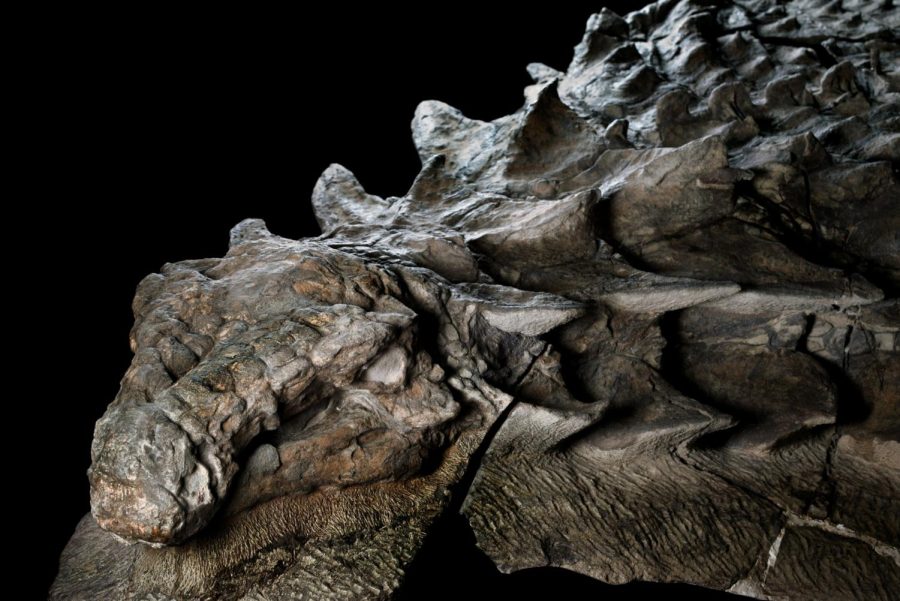Mummified Dinosaur
A Discovery that Leads to Knowledge
Dinosaurs are awesome; there is no better way to say it. It is amazing to think that creatures such as the T. Rex and Brachiosaurus actually lived on the same planet we live on today. But dinosaurs are not just massive creatures that lived a long time ago. They offer clues and most importantly knowledge as to how evolution works and how the Earth has changed over time.
A corpse of a 110-million-year-old dinosaur was discovered accidentally by two mine workers working in the Suncor Millennium Mine in Alberta, Canada in 2011. The miners were working on an excavator that was mining for coal and oil sands as they bumped into what the workers described as a big piece of rock.
After taking a closer look they realized that the “piece of rock” actually looked like a dinosaur. Based on information provided from a full analysis of the stomach of the dinosaur found it has been confirmed that this was in fact a nodosaurus (Borealopelta markmitchelli) fossil, a close cousin to the more commonly known dinosaur the Ankylosaurus.
The nodosaur corpse, which was missing its tail, measured 18 feet long (5.5 meters), had two 20-inch long spikes on its shoulders and weighed nearly 3,000 pounds when discovered. All bones were still intact under the tough skin, overall in good condition. The extraction of the remains took about five years to complete and 7,000 long hours to prepare for display.
Paleontologists, scientists who study the history of life on Earth through the fossil records, thought such a discovery was highly unlikely in this type of condition. So this brought forth a huge surprise to such a pristine dinosaur fossil discovered to date for the last 150 years of paleontology.
Daniel L. Brinkman, Museum Assistant II, Division of Vertebrate Paleontology from the Yale Peabody Museum explains how the discovery of the nodosaurus dinosaur was preserved and how its stomach was completely intact. “This creature roamed the Earth at a time when much of the land consists of floodplains. When dinosaurs such as the nodosaurus rots from death the body fills up with gases. These gases cause a bloat and float response. Very similar to a balloon. The dinosaur was believed to have been swept away in the raging floods and then buried in a muddy area which helped encapsulate the dinosaur fossil.”
Such things as escaping predators, scavengers or rotting by water and weather conditions all have a huge impact on the mummifying process. A chemical process had to have taken place to help mineralize the tissue before bacteria ate it.
Bacteria play an important role in decomposing, and minerals help to preserve the dinosaur’s exterior skin. Food in the digestive tract is hardened by minerals given off from the bacteria which help keep the stomach contents preserved.
The contents found in the dinosaur’s stomach, who was an herbivore, were such things as plants and flavored ferns. Details of the dinosaur’s diet were so preserved that the leaf fragments and other plant fossils were preserved down to the cell.
These details also help to provide a glimpse into what this dinosaur’s daily life, activities and or the region was like where they once roamed. An article from CNN quotes study co-author David Greenwood saying, “We could see the different layers of cells in a leaf fragment including the epidermis with the pores, called stomata, through which plants take in carbon dioxide. We could also see the surface patterning of the epidermis cells, which was like a jigsaw pattern that we see on many living ferns.”
The stomach also revealed that the dinosaur had charcoal in its gut, drawing conclusions that the dinosaur must have been grazing on land that was hit by wildfires. Research from an article published by National Geographic states, “The researchers know that forest fires were common in forests during the early Cretaceous period, 100 million to 145 million years ago. And after forest fires, ferns flourish low to the ground.” The grazing of these herbivore dinosaurs during these times had an impact on the shaped landscape that surrounded the areas they roamed.
Mrs. Dawn Davis, a science teacher at Foran, reflects on what the discovery tells the world. She says, “These new discoveries lead us to a better understanding of these extinct species and, depending on what is found, will help shed some light into the diets of any related dinosaurs.”
Land minerals and soil also play a role in preserving a fossil as large as a dinosaur, Davis explains, “When an organism dies and decomposes, the parts that remain are the hardened parts, usually bone or some imprints that might remain. The sedimentary rock found in layers of the Earth can be exposed through other natural forces or the process of excavation to help make these discoveries.”
These heavy armored dinosaurs used their exterior to help defend them from their predators. Brinkman states, “The nordosaurs had a very interesting feature called counter shadowing which helped them blend into their environments to protect them from being another dinosaur such as the T-Rex’s prey.”
The nodosaur species is a unique species and the most amazing paleontological discovery to date. This mummified discovery opens our minds to what else could be living under our Earth’s layers.
This great mummified nodosaurus can be seen by the public at the Royal Tyrrell Museum in Alberta, Canada.
Your donation will support the student journalists of Foran High School. Your contribution will allow us to purchase equipment and cover our annual website hosting costs.

Hello, My name is Gavin Fanelli and I'm a junior at Foran High School. This is my third year of being a staff writer of the Mane Street Mirror. I play...








Nicole | Mar 12, 2022 at 4:16 PM
Great article Gavin! Keep up the great writing.